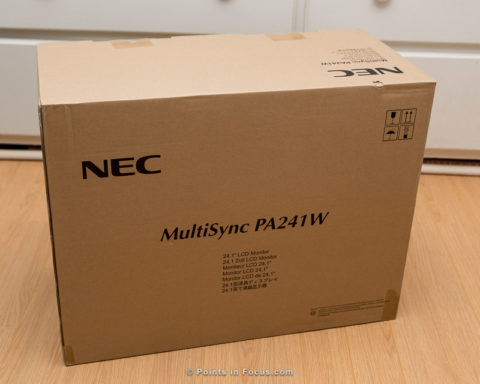Adventures in Displays; Good bye Dell, Hello NEC
I’ve had good luck with Dell LCD displays. My first Dell LCD, a 2001FP is still alive and kicking after more than 10 years of daily use. Heck until recently, I’ve never had a problem with a Dell display; that was until my venerable 2408WFP decided that it was time to start its death spiral.
The first indicators were that display would just flick to a black screen and return. Perhaps, desperately clinging to the hope that I wouldn’t have to go display shopping, I changed cords and video cards, and nothing helped.
With nothing left to replace between the computer and the display, there wasn’t much doubt. Moreover, any remaining doubt was erased when a series of extended power outages prompted serious problems with bringing the display back to life from a cold state.
After doing a little research, it turns out early 2408WPF have a failure mode where they’ll refuse to power up properly when brought up from a cold start. So long as power is applied, and the display only asleep, it will function perfectly fine, at least until it doesn’t; and while there’s a workaround to get the display back up from a cold start, it’s seriously not fun to have to do.
The Abridged Dell U2410 Non-Review
Since Dell displays have served me well and since the U2410 seemed well received, it seemed like an obvious choice.
To say this isn’t a review would be an understatement. I had a U2410 for exactly 24 hours before I had to return it due to the glaring color issues.
From a tic-box perspective, like the 2408WFP, the U2410 has it all, Display Port, HDMI, two DVI, component, composite, and S-video, a 4-port USB2 hub, and an SD/SDHC/etc. and CompactFlash media card reader, revised stand with lots of choices, touch controls (which I dispise), and blue LEDs.
Then there’s the picture, at least in theory.
The U2410’s 8-bit + AFRC panel, 12-bit processing, and expanded gamut backlight should in theory allow the display to produce significantly more shades of reds, magentas, and blues, at the cost of some greens and cyans, at least compared to the 2408WPF and at least if you get a good display.
After the initial, “wow, look at the colors factor,” wore off, the real problem with the display I received hit me. There was a serious differential red/magenta cast across the display that couldn’t simply be profiled away. Yellows in a sunset had become oranges; blues in the sky had become purples. The images in a way may have looked “nice”, but they also were wrong. In fact, having now put my NEC PA241W-BK into service, and calibrated it, how wrong the U2410 got things is simply staggering.
Magenta and green casts were a widely reported problem for the 2408WPF, somehow I managed to completely avoid it by luck of the draw. Most of the reviews of the U2410 suggested that the magenta/green cast issues had been resolved, or at least weren’t significant enough to be an issue.
I can only really say, the reviewers must not be real discerning, or their luck is better than mine is. Moreover, I don’t have the best color vision in the world, so when I can see a problem there’s a serious problem. Unfortunately, the photographic communities suggested that the green/magenta issue might be more of an issue than the reviewers were suggesting, with at least one person posting that they had to go through 3 displays before they got a good one.
This brings me to the conclusion of my Dell Ultrasharp U2410 non-review. It had the promise of being a great display at a decent price. However, the prospect of playing musical displays to get one that didn’t have color issues turned me off to going any further down that road. Perhaps I’m being a bit unfair to Dell, it’s very possible that I got a rare bad monitor and that the vast majority of them are much better.
Unfortunately, I’ve lost any patience I use to have with dealing with these kinds of computer issues. There’s no fun in replacing displays, and even less when there’s a chance, possibly a good chance, that I’ll have the same problem with the replacement.
So the display went back, and I got something else…
Something, “pro”…
NEC PA241W-BK
When it comes to high-end displays, there are really only 2 choices: NEC’s Spectraview ready Multisyncs, and EIZO’s ColorEdges. They’re the pinnacle of professional color critical displays, and I’ve wanted one ever since I got serious with photography.
I plan to write a more in-depth “review” about the display in the future, however, for the moment I want to give my first impressions.
The experience starts at the box, and unboxing the PA241W was comparatively a joy. There’s no assembly, the display comes on its stand standing upright in the box. Better yet, instead of trying to fiddle with getting the display out of the packing, there’s a convenient handle to lift it by and it just lifts out. Never mind, a handle, while such a small detail, is incredibly useful when maneuvering a 24” LCD around and into position on my desk.
Fortunately, the colors on the PA241W are considerably more in line with what I expected them to be. There aren’t massive orange/red/magenta overtones in images. The expanded color gamut (which is very similar to what the U2410 should have) definitely allows more reds and blues to be seen when they’re there, but there aren’t the wild irregularities in the colors that I was seeing with the U2410.
All told, the images really do look a lot like the prints I’ve made, and that makes me a happy photographer.
